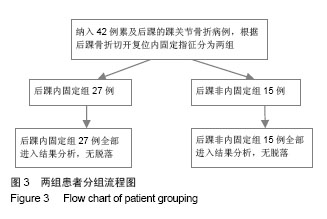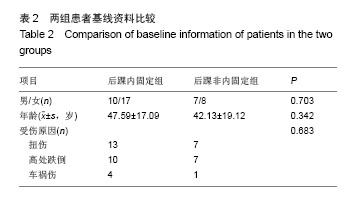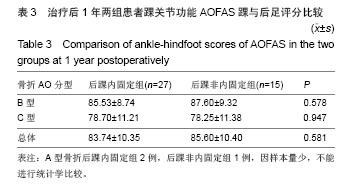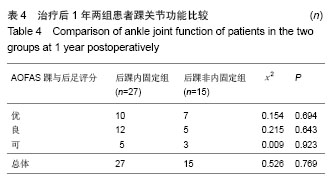3.1 后踝骨折固定的指征 踝关节是一个结构复杂的鞍状负重关节,与距骨滑车相匹配,虽然Harper等
[10]及Raasch等
[11]通过试验得出即使后踝发生了骨折移位,如果保持外踝的稳定性,则距骨也不会向后方移位。但后踝的移位或缺失会造成胫距关节接触面积减小,胫距关节单位面积上的压力增加,整个踝关节的负重区域也会发生变化,出现胫距关节后方不稳定,继发创伤性踝关节炎。故后踝骨折块的大小及移位程度可以直接影响胫骨与距骨关节面的接触面积,继而改变胫距关节之间的应力分布,这种应力分布的改变极易导致创伤性踝关节炎的发生。
目前对于后踝骨折块在修复术中内固定与否尚无统一的判断标准,有些学者认为,后踝骨折块累及超过胫骨远端关节面的1/4-1/3,或在腓骨复位后后踝骨折块仍存在大于2 mm的移位,需手术精确复位内固定
[3-5]。然而,汤荣
光等[12]通过尸体研究发现,踝关节完整的关节面负重区域面积为(3.93±0.30) cm
2,后踝切除1/4时关节面负重区域面积为(3.42±0.38) cm
2,两者差异有显著性意义。Macko等
[13]亦通过在尸体上进行生物力学研究发现,当后踝骨折块累及胫骨远端关节面达25%,足在中立位时胫距关节的接触面积减少12%。虽然这两位学者所作研究均未直接涉及后踝骨折块累及胫骨远端关节面10%的数据,但根据其研究结果可以看出,当后踝骨折块累及胫骨远端关节面25%时,胫距关节的接触面积与正常踝关节的胫距关节接触面积有显著差异,故认为将25%作为后踝内固定与否的界限不太恰当。
但究竟多大的后踝骨折块才是内固定的标准呢?作者认为可截成不同的大小的后踝骨折块(如5%,10%,15%及20%等)进行踝关节的生物力学研究,并在此基础上经多个临床中心大量病例的长期随访研究后才能得出。Langenhuijsen等
[6]对57例累及后踝的踝关节骨折患者行闭合复位或切开复位内固定治疗,术后X射线片显示39例患者恢复了胫骨远端关节面的平整,18例患者因后踝骨折块移位致胫骨远端关节面仍不平整,通过平均6.9年的随访发现当后踝骨折块累及超过胫骨远端关节面的10%时,无论是否行内固定治疗,胫骨远端关节面平整的患者预后显著好于不平整的患者,并认为在后踝骨折块累及超过胫骨远端关节面的10%时,后踝是否固定与患者的预后显著相关,即应手术精确复位并行内固定,否则将改变胫距关节的接触应力,增加创伤性踝关节炎的发生率。Goreham-Voss等
[7]利用多孔弹性软骨有限元模型来模拟软骨在不平整关节内的负载活动,研究得出,若关节面骨折部位存在≥2 mm的台阶,无论骨折是否固定,都会有关节压力的异常分布及峰值压力的出现。因此,将后踝骨折块累及胫骨远端关节面大于10%,或/和移位大于2 mm作为后踝骨折切开复位内固定的指征。作者认为,当后踝骨折块累及胫骨远端关节面比例位于10%-25%时,术中仅需将外踝处切口向后稍作延长,复位后踝,予以螺钉内固定,此过程并不复杂,而且可以降低术后踝关节石膏固定引起的踝关节僵直的风险,有效防止后踝骨折块移位。俞光荣等
[14]认为,当后踝骨折块累及胫骨远端关节面小于10%,且存在下胫腓联合不稳时,可作为手术固定后踝的指征。但根据临床经验,若骨折块太小,使用螺钉固定时易致后踝骨折块劈裂。故对于累及胫骨远端关节面小于10%的后踝骨折块,不予内固定,若此时存在下胫腓联合不稳,可用下胫腓螺钉来固定。
治疗后1年时发现固定组与非固定组的AOFAS踝与后足评分的差异无显著性意义,其优良率与俞光荣等
[14]所作后踝骨折内固定治疗的疗效相当,故认为当后踝骨折块累及胫骨远端关节面小于10%时,无需内固定。Jaskulka等
[8]及Broos等
[15]通过临床研究也认为,当后踝骨折块较小(累及胫骨远端关节面小于10%)时可不行内固定治疗。而当后踝骨折块大于胫骨远端关节面的10%时,若不进行固定,在踝关节活动中胫距关节的接触应力易致后踝骨折块向后、向上移位,在胫骨远端关节面形成一个台阶,影响胫距关节的应力分布,从而导致踝关节的疼痛和创伤性踝关节炎的发生。
另外,后踝还影响下胫腓关节的稳定性。下胫腓后韧带及下胫腓横韧带均连接腓骨远端后内侧与胫骨远端后外侧,与外、后踝共同维持下胫腓关节及踝穴的稳定,文哲等
[16]通过对175例后踝骨折研究发现后踝骨折是由于距骨撞击后踝和下胫腓后韧带牵拉所致,Gardner等
[17]亦通过尸体研究得出后踝骨折的固定有利于稳定下胫腓关节,故后踝是影响下胫腓关节稳定的重要因素之一。术中作者在复位固定内外后踝后,提拉外踝,若发现下胫腓联合间隙大于3 mm,则判断为下胫腓联合分离。在本研究固定组中,下胫腓联合需固定的为6例,占22%(6/27),而在非固定组中,下胫腓联合需固定的为11例,占73%(11/15)。这是因为在固定组中,后踝骨折块已通过螺钉固定,此时下胫腓联合重新获得稳定,故术中通过提拉外踝发现下胫腓联合分离的病例数少于非固定组。在固定组中即使后踝骨折已行固定,仍有6例需使用下胫腓螺钉,这是因为除了后踝骨折外还存在下胫腓韧带的断裂。同理,在非固定组中,下胫腓联合不稳定的原因是后踝骨折和下胫腓韧带断裂,无论是哪种原因造成的不稳,均可使用下胫腓螺钉来固定,而无需固定后踝,因此,非固定组中使用下胫腓螺钉的病例数明显高于固定组。
3.2 治疗后并发症 Miller等
[18]对踝关节骨折内固定后的伤口并发症发生风险进行分析,结果显示:年龄、糖尿病史、周围神经病变、软组织损伤程度、伤口局部用药、开放性骨折及术后不配合治疗等因素与伤口并发症呈显著相关关系,而手术持续时间则与伤口并发症之间无显著相关性。
本文固定组中1例患者术后出现踝关节内外侧伤口红肿,经抗感染治疗后伤口愈合。该患者为40岁中年女性,既往体健,无高血压、糖尿病等基础疾病,于伤后1 d来本院,查体见右踝关节皮肤发红,肿胀明显,内踝处有数个张力性水泡,诊断为右侧三踝闭合性骨折、踝关节蜂窝织炎,行跟骨牵引、抗感染、消肿等治疗,于伤后17 d右踝肿胀消退后行切开复位内固定。该患者内固定后伤口感染可能与治疗前软组织损伤严重,且继发踝关节蜂窝织炎有关,故对局部有蜂窝织炎的患者,即使在感染控制后进行内固定,治疗前与患者沟通时,仍然应强调治疗后感染的风险较高。
结论:后踝是影响踝关节创伤性关节炎及下胫腓关节稳定的重要因素之一。当后踝骨折块累及超过胫骨远端关节面的10%,或/和移位大于2 mm时,应予行切开复位内固定,并尽量达到解剖复位,以恢复胫骨远端关节面的平整;当后踝骨折块累及小于胫骨远端关节面的10%且移位小于2 mm时,可不予行内固定,但此时应维持下胫腓联合的稳定性。故可将后踝骨折块累及胫骨远端关节面大于10%,或/和移位大于2 mm作为踝关节骨折中后踝内固定的适应证。




.jpg)
.jpg)
.jpg)